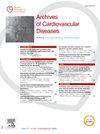心脏磁共振成像在室性早搏患者中的应用:对哪些患者有用?
IF 2.3
3区 医学
Q2 CARDIAC & CARDIOVASCULAR SYSTEMS
引用次数: 0
摘要
背景心脏磁共振(CMR)在早衰心室复合体(pvc)中的作用尚未明确定义。目的本研究的目的是评估CMR检测室性早搏患者在初始检查后的结构异常的性能,并确定异常的预测因素。方法回顾性分析200例患者;所有患者都是由他们的心脏科医生在初步检查后推荐的,包括心电图、超声心动图和跑步机运动心电图检查。图像在1.5和3特斯拉扫描仪上获得,采用标准方案(电影成像和造影剂后的晚期钆增强序列)。CMR的性能被定义为检测到先前在初始检查中未发现的结构异常。结果scmr显示结构异常的病例占48%,以非缺血性纤维化为主(25.5%),其次为缺血性纤维化(9%)和混合性纤维化(2%),并诊断出5种心肌病。在多变量分析中,预测结构异常的主要因素是年龄;64岁(HR 2.23;P = 0.028),男性(HR 2.59;P = 0.012),糖尿病(HR 6.13;P = 0.006),已知心肌病(HR 4.34;P = 0.001),多形性室性早搏(HR 3.74;p = 0.007)。相比之下,在没有已知心肌病和超声心动图正常的年轻非糖尿病患者中,左束分支阻滞形态的室性早搏呈下轴逐渐下降,CMR均正常(图1、图2、图3)。结论cmr在评估室性早搏中至关重要,因为它可以检测到几乎一半的病例(48%)在最初的检查中没有发现的结构异常。结构异常的预测因素包括男性,>;64岁,糖尿病,已知心肌病和多形性室性早搏。相反,年轻和非糖尿病患者超声心动图正常,左束支阻滞形态的室性早搏,下轴随用力减少,CMR正常100%,可能不需要进行这项检查。本文章由计算机程序翻译,如有差异,请以英文原文为准。
Cardiac magnetic resonance imaging in patients referred for premature ventricular contractions: Is it useful and for which patient?
Background
The role of cardiac magnetic resonance (CMR), in case of premature ventricular complexes (PVCs), is not clearly defined.
Objectives
The purpose of this study was assess the performance of CMR to detect structural abnormalities in patients routinely referred for PVCs after an initial workup and to determine predictive factors of abnormalities.
Methods
200 patients were retrospectively included; all referred by their cardiologist after an initial workup including ECG, echocardiography and treadmill exercise ECG test. Images were acquired on a 1.5 and 3 Tesla scanner with a standard protocol (cine imaging and late gadolinium enhancement sequences after contrast administration). The performance of CMR was defined as the detection of structural abnormalities not previously not found on the initial workup.
Results
CMR revealed structural abnormalities in 48% of cases, mainly non-ischemic fibrosis (25.5%) followed by ischemic fibrosis (9%) and mixed fibrosis (2%), as well as the diagnosis of 5 cardiomyopathies. In multivariate analysis, the main predictors of structural abnormalities were age > 64 years (HR 2.23; P = 0.028), male sex (HR 2.59; P = 0.012), diabetes (HR 6.13; P = 0.006), known cardiomyopathy (HR 4.34; P = 0.001), and pleomorphic PVCs (HR 3.74; P = 0.007). In contrast, left bundle branch block morphology PVCs with inferior axis decreasing with effort in young non-diabetic subjects without known cardiomyopathy and with normal echocardiography all have a normal CMR (Figure 1, Figure 2, Figure 3).
Conclusion
CMR is essential in the assessment of PVCs as it enables the detection of structural abnormalities not found with the initial workup in almost half of the cases (48%). Predictive factors of structural abnormalities include men, > 64 years, diabetic with a known cardiomyopathy and pleomorphic PVCs. On the opposite, young and non diabetic patients with normal echocardiography and left bundle branch block morphology PVCs with inferior axis decreasing with effort have a normal CMR in 100% and could potentially not need this examination.
求助全文
通过发布文献求助,成功后即可免费获取论文全文。
去求助
来源期刊

Archives of Cardiovascular Diseases
医学-心血管系统
CiteScore
4.40
自引率
6.70%
发文量
87
审稿时长
34 days
期刊介绍:
The Journal publishes original peer-reviewed clinical and research articles, epidemiological studies, new methodological clinical approaches, review articles and editorials. Topics covered include coronary artery and valve diseases, interventional and pediatric cardiology, cardiovascular surgery, cardiomyopathy and heart failure, arrhythmias and stimulation, cardiovascular imaging, vascular medicine and hypertension, epidemiology and risk factors, and large multicenter studies. Archives of Cardiovascular Diseases also publishes abstracts of papers presented at the annual sessions of the Journées Européennes de la Société Française de Cardiologie and the guidelines edited by the French Society of Cardiology.
 求助内容:
求助内容: 应助结果提醒方式:
应助结果提醒方式:


